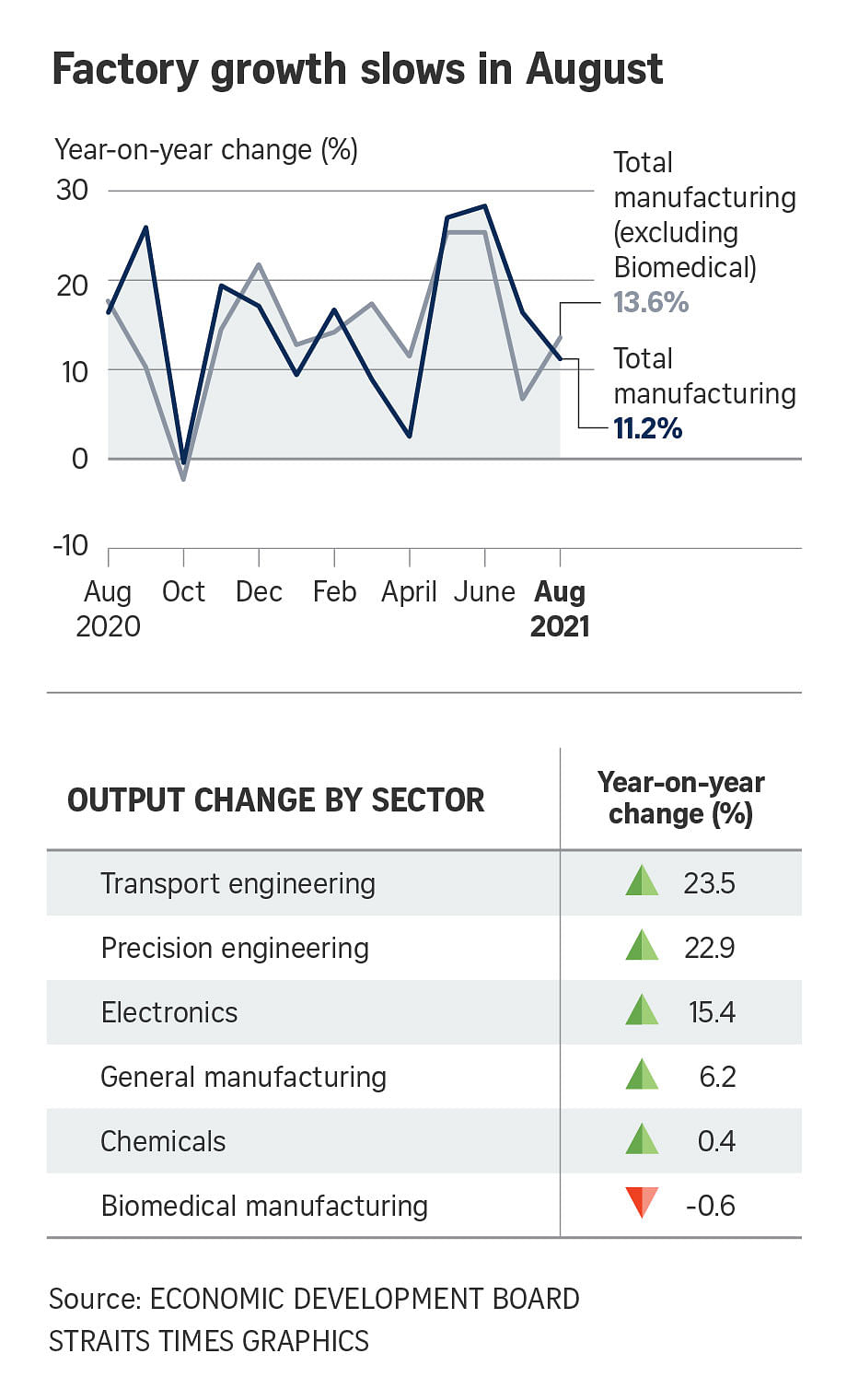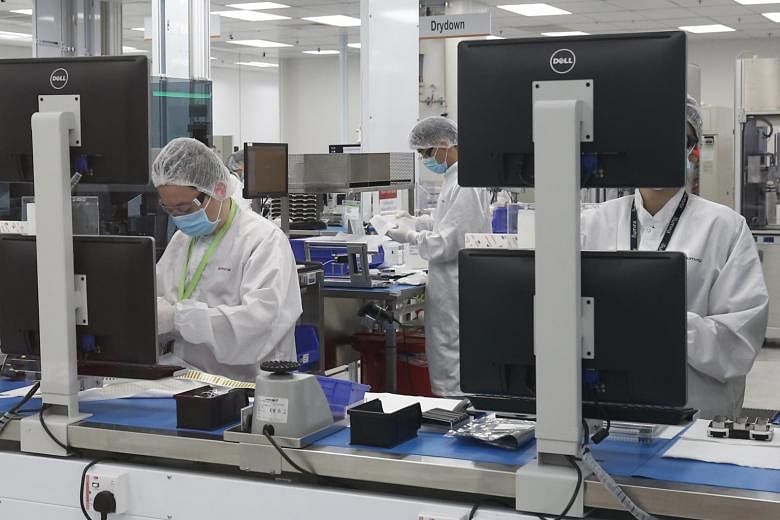SINGAPORE - Singapore's factory growth slowed again in August with economists expecting the moderation to continue for the rest of the year amid pandemic-related supply disruption and cooling external demand.
Manufacturing output expanded 11.2 per cent last month from a year ago, down from a revised 16.4 per cent increase in July, on the back of a drop in biomedical production, according to data out on Friday (Sept 24).
Still, the performance marked a 10th straight month of year-on-year growth and beat the 8.2 per cent increase forecast by analysts in a Bloomberg poll.
Excluding biomedical manufacturing, output increased 13.6 per cent in August.
The key electronics sector saw output expand by 15.4 per cent. Apart from the computer peripherals and data storage segment, all segments recorded output growth.
Notably, the semiconductors segment grew 16.8 per cent, supported by demand from 5G markets, after eking out growth of just 1.4 per cent in July.
But experts are not very optimistic regarding chip production outlook.
Ms Selena Ling, OCBC Bank head of treasury research and strategy, said: "There were many news reports citing chip shortages being attributed to factories being shut due to Covid-19 outbreaks in Malaysia and Vietnam. Even America is trying to get more data from its chipmakers to figure out who's potentially hoarding supplies.
"So I'm not sure the global chip shortage issue has been resolved. It probably is still something to watch."
Maybank Kim Eng economists Chua Hak Bin and Lee Ju Ye added: "While demand for chips will remain resilient, production is already operating at near full capacity. Fresh investments - from the likes of Micron, Infineon, ST Microelectronics and GlobalFoundries - will expand chip manufacturing capacity but this will likely materialise in 2022 at the earliest."
They added that chip lead times - the gap between ordering a semiconductor and taking delivery - worsened to 21 weeks in August, up by six days from July, according to the Susquehanna Financial.
Meanwhile, the volatile biomedical manufacturing sector saw its output fall 0.6 per cent. While the medical technology segment rose 8.2 per cent on the back of higher export demand for medical devices, the pharmaceuticals segment declined 3.4 per cent due to a different mix of active pharmaceutical ingredients.
On a year-to-date basis, the biomedical manufacturing cluster still grew 9.8 per cent.
All other sectors posted year-on-year growth in August.
The transport engineering cluster saw expanded output of 23.5 per cent, with all segments recording growth.
The marine and offshore engineering segment rose 36.9 per cent, while the aerospace segment increased output by 22 per cent.
The Economic Development Board (EDB) said: "The levels of activity in the shipyards and aerospace firms had increased from a low base last year when new orders were impacted by the weak global oil and gas market and international travel restrictions amid the Covid-19 pandemic."
Cumulatively, the transport engineering cluster grew 4.7 per cent in the period lasting from January to August, compared with the same period last year.
Precision engineering output also grew by 22.9 per cent in August. The cluster's growth was largely attributed to the machinery and systems segment, which grew 33.1 per cent with higher output of semiconductor and industrial process equipment.
Overall, the precision engineering cluster grew 19.9 per cent in the first eight months of 2021.
Meanwhile, general manufacturing output climbed 6.2 per cent, with the miscellaneous industries segment growing 33.2 per cent from a low base last year, when demand for construction-related materials was adversely affected by Covid-19.
Conversely, the food, beverage and tobacco segment fell 6 per cent, while the printing segment dropped 16.7 per cent, with lower production of milk powder due to weaker export demand.
In the first eight months of this year, output from the general manufacturing industries cluster grew 7.7 per cent, compared with the same period last year.
Chemicals output edged up by 0.4 per cent. The petroleum segment recorded an output growth of 22.1 per cent from the low production base a year ago due to lower export demand amid the Covid-19 outbreak.
But the specialities, petrochemicals and other chemicals segments contracted slightly. In particular, the petrochemicals recorded lower production due to plant maintenance shutdowns.
Overall, the chemicals cluster grew 9.2 per cent year on year from January to August this year.
Dr Chua and Ms Lee said they expect manufacturing growth to continue moderating for the rest of the year as high base effects kick in for September, especially with pharmaceuticals and semiconductors.
Ms Ling added that external demand may also have plateaued with the growth momentum peaking in the United States and China.
"Nevertheless, with the first eight months output growth already at 14.3 per cent year on year, even if the remaining four months moderates, full-year growth should still be fairly healthy," she said.



